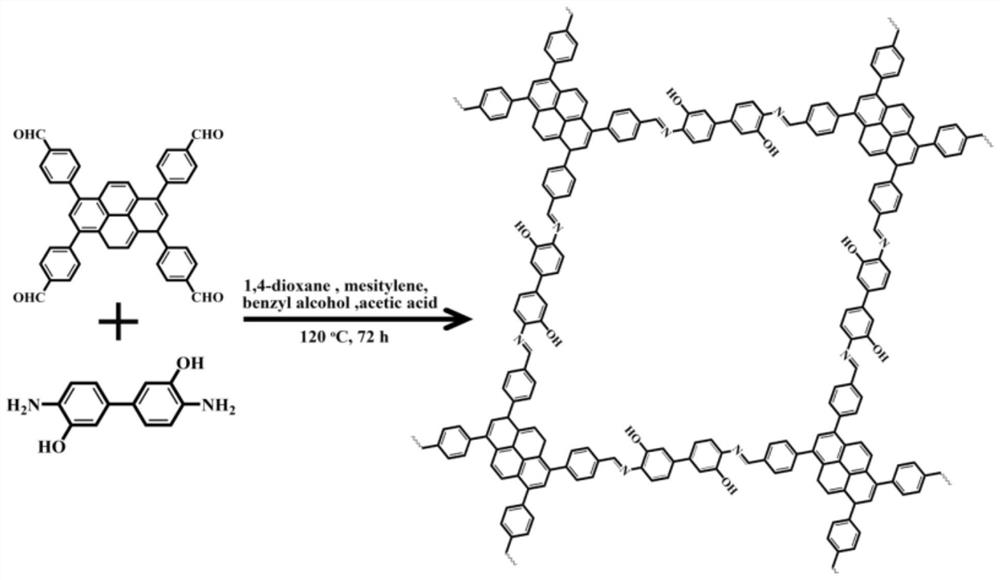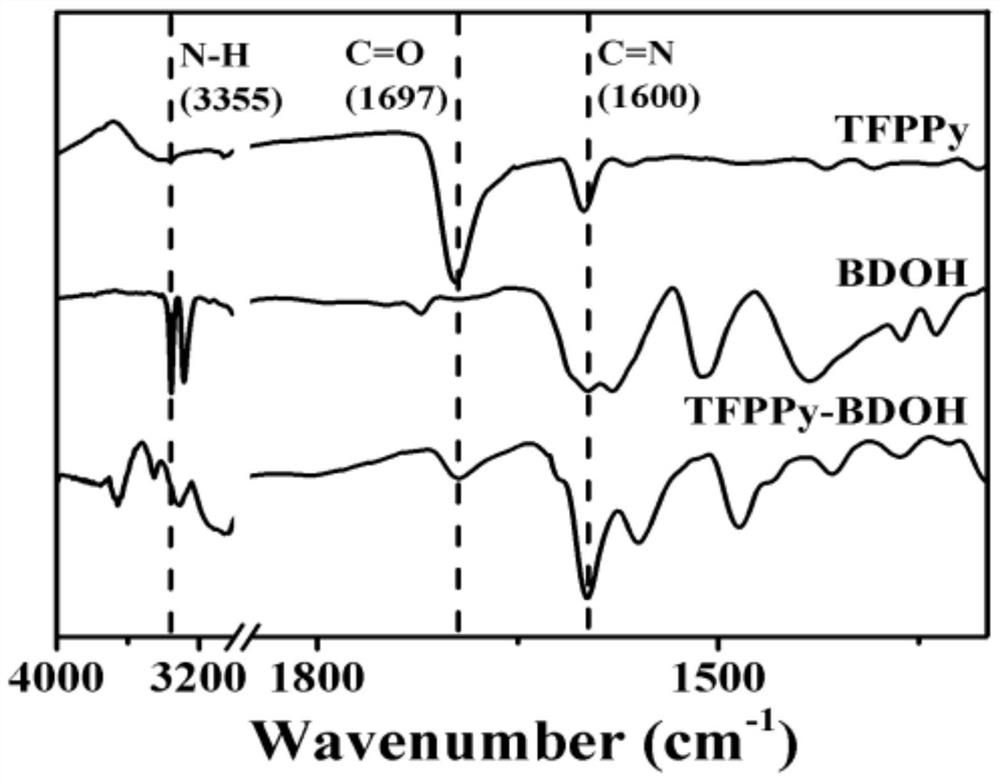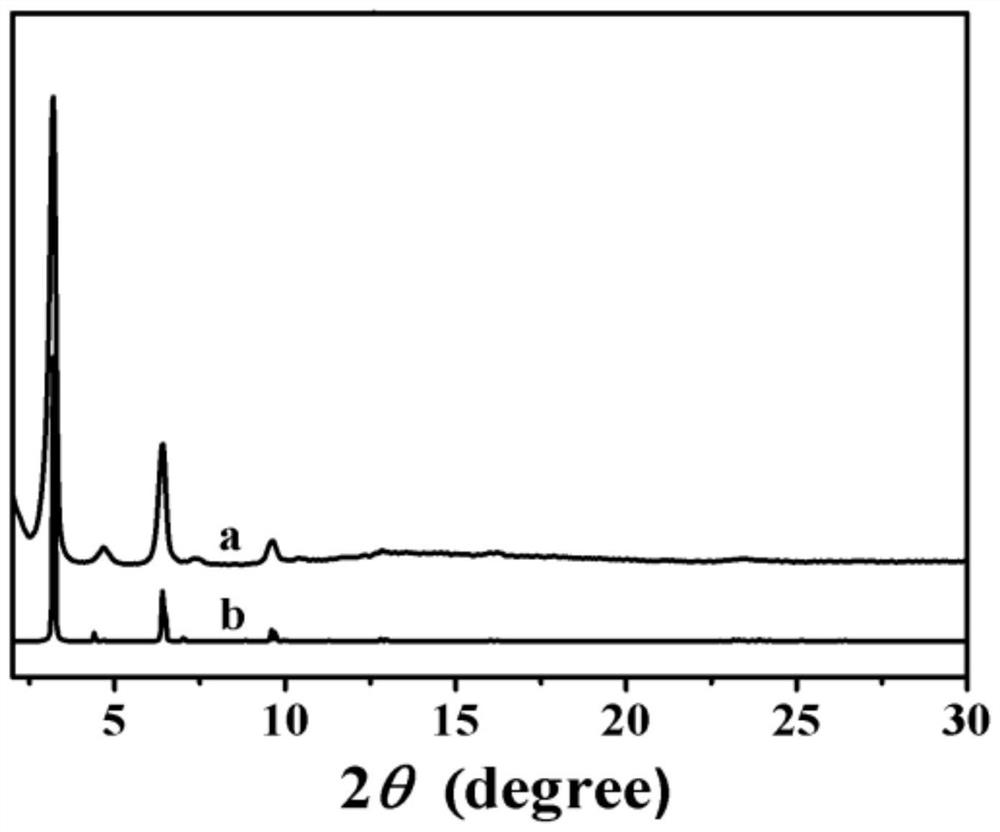Preparation method and application of a fluorescent covalent organic framework linked by imine bonds
A technology of covalent organic framework and imine bond, which is applied in the field of preparation of fluorescent covalent organic framework, can solve the problems of reducing porosity and crystallinity, and achieve the effect of improving adsorption capacity, good selectivity and efficient adsorption
- Summary
- Abstract
- Description
- Claims
- Application Information
AI Technical Summary
Problems solved by technology
Method used
Image
Examples
Embodiment 1
[0030] Example 1: Preparation and characterization of imine-linked fluorescent covalent organic frameworks
[0031] 1,3,6,8-Tetrakis(4-formylphenyl)pyrene (TFPPy) (24.7 mg, 40 μmol) and 4,4'-diamino-[1,1'-biphenyl]-3,3 '-Diol (BDOH) (17.3 mg, 80 μmol) into a 20 mL Pyrex tube, followed by addition of 1,4-dioxane (800 μL), benzyl alcohol (800 μL), mesitylene (1334 μL) and acetic acid solution ( 200 μL, 6M); the suspension was sonicated for 10 min, then frozen in a 77K liquid nitrogen bath, and after degassing through three freeze pump-thaw cycles, the tube was evacuated and flame sealed; the tube was placed in an oven at 120 °C Heating for 72h under conditions, cooling to room temperature, collecting the solid product after filtration, washing with tetrahydrofuran (THF) for several times, vacuum drying to obtain a solid, vacuum drying at 80°C for 12h to prepare imine-bonded fluorescent covalent organic Framework (TFPPy-BDOH).
[0032] figure 1 Schematic diagram of the synthet...
Embodiment 2
[0035] Example 2: Detection of uranyl ions by TFPPy-BDOH
[0036] Make up TFPPy-BDOH to 0.025mg mL -1 of N,N-dimethylacetamide (DMAC) dispersion liquid, take 360 μL of dispersion liquid, add 40 μL of uranyl ions of different concentrations, so that the final concentration of uranyl ions is 0-25 μM, after shaking evenly, use fluorescence spectrophotometry The fluorescence signal of the mixture was measured under the condition of excitation wavelength of 325nm.
[0037] Figure 4 Fluorescence response of TFPPy-BDOH to different concentrations of uranyl ions. Depend on Figure 4 It can be seen that with the uranyl ion (UO 2 2+ ) concentration, the fluorescence signal of TFPPy-BDOH gradually decreased, and 25 μM UO 2 2+ The fluorescence quenching rate of TFPPy-BDOH can reach more than 90%. Fluorescence signal of TFPPy-BDOH and UO 2 2+ Concentration is linear in the range 0-25 μM, with respect to UO 2 2+ The detection limit was 8.8 nM. In addition, TFPPy-BDOH has no ...
Embodiment 3
[0038] Example 3: Adsorption capacity of TFPPy-BDOH for uranium
[0039] Add 5 mg of TFPPy-BDOH to the solution containing 10-300 ppm uranyl ions, shake at constant temperature in a shaker for 12 h, take 1 mL of the suspension, filter it with a 0.22 μm microporous membrane, collect the filtrate, and use inductively coupled plasma mass spectrometry. Measure the remaining UO in the filtrate 2 2+ content, the final calculation of TFPPy-BDOH to UO 2 2+ The adsorption capacity of 982.6 mg / g is higher than that of most existing materials. For example, the adsorption capacity of the carboxyl-functionalized zinc MOF material developed by Liu et al. zinc MOF with carboxylate oxygen-functionalized pore channels for uranium(VI)sorption, Eur.J.Inorg.Chem., 2019, 735-739), Sun et al. based on amidoxime-based COF material adsorption capacity 408mg / g (Q.Sun ,B.Aguila,L.D.Earl,C.W.Abney,L.Wojtas,P.K.Thallapally,S.Ma.Covalent organic frameworks as adecorating platform for utilization and ...
PUM
| Property | Measurement | Unit |
|---|---|---|
| adsorption capacity | aaaaa | aaaaa |
Abstract
Description
Claims
Application Information
 Login to View More
Login to View More - R&D
- Intellectual Property
- Life Sciences
- Materials
- Tech Scout
- Unparalleled Data Quality
- Higher Quality Content
- 60% Fewer Hallucinations
Browse by: Latest US Patents, China's latest patents, Technical Efficacy Thesaurus, Application Domain, Technology Topic, Popular Technical Reports.
© 2025 PatSnap. All rights reserved.Legal|Privacy policy|Modern Slavery Act Transparency Statement|Sitemap|About US| Contact US: help@patsnap.com



